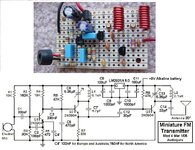akbarza
Full Member level 2
hi
I attached a pic of a circuit and the .asc file( ltspice file).
inthe file MIC is microphon( i did not find symbole or component in ltspice for microphon).
the transistor is pnp. how can i find the Q- point with calculation? then according to bias point,
what is the class of this transistor?
why in this circuit, a pnp transistor has been used and not a npn transistor?
thanks
I attached a pic of a circuit and the .asc file( ltspice file).
inthe file MIC is microphon( i did not find symbole or component in ltspice for microphon).
the transistor is pnp. how can i find the Q- point with calculation? then according to bias point,
what is the class of this transistor?
why in this circuit, a pnp transistor has been used and not a npn transistor?
thanks
